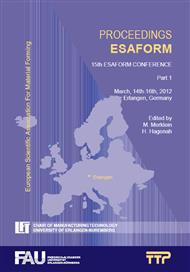p.199
p.205
p.213
p.219
p.225
p.231
p.237
p.243
p.249
Characterization and Finite Element Modeling of Unidirectional Non-Crimp Fabric for Composite Manufacturing
Abstract:
A hybrid finite element discrete mesoscopic approach is proposed to model the forming of composite parts using a unidirectional glass prepreg non-crimp fabric (NCF). The tensile behavior of the fabric is represented using 1-D beam elements, and the shearing behavior is captured using 2-D shell elements. The material is characterized using tensile and shear frame tests. These properties are then incorporated into an ABAQUS/Explicit finite element model via user-defined material subroutines. The shear frame characterization test is simulated using a finite element model of the fabric, and the finite element results are compared to experimental data as a validation of the methodology. The thermostamping of a double-dome geometry, which has been used in an international benchmarking program, is modeled as a demonstration of the capabilities of the proposed methodology.
Info:
Periodical:
Pages:
225-230
Citation:
Online since:
February 2012
Keywords:
Price:
Сopyright:
© 2012 Trans Tech Publications Ltd. All Rights Reserved
Share:
Citation:


